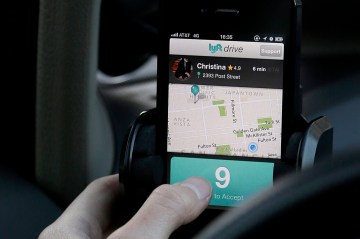See the rest of TIME’s Top 10 of Everything 2013 lists here

10. Duolingo
In an age of free online education for everything from microeconomics to computer coding, Duolingo is a welcome addition for those trying to learn a foreign language. The site offers lessons in six languages and has 5 million monthly active users. Even more disruptive is the site’s crowdsourcing platform to get its users to translate texts and help Duolingo develop courses for more languages. BuzzFeed has partnered with the company to translate its content into Portuguese, Spanish and French.
9. Patreon
Since rising to prominence with Kickstarter, crowdfunding has splintered off into lots of smaller sites serving very specific niches. One such site is Patreon, a company that aims to let users everywhere become patrons of the arts. Artists who make music or release YouTube videos can receive regular payments from their patrons every time they release a new piece of content. They’re essentially paid for their work regularly instead of having to pitch a big new idea to potential crowd funders each time. The site, launched this year, has received at least $2.1 million in venture funding so far.
8. Beyond Meat
An increasing number of startups in the food sector are looking for ways to extend the world’s food supply through engineering. One of the most prominent is Beyond Meat, a company that develops a faux-chicken product by mixing soy and pea proteins. The chicken-like food has tricked food writers in taste tests and is now being carried at Whole Foods around the country. The food, which requires significantly fewer resources to create than the raising and processing of chickens on factory farms, could prove an essential food source for people worldwide in the future.
7. Pebble
First, Pebble smashed records on the crowdfunding website Kickstarter, earning more than $10 million in donations in just 37 days in 2012. This year came a much harder task for the company: actually delivering the first mass-market smartwatch to thousands of people. The product suffered multiple delays last year but finally began shipping to Kickstarter backers at the start of 2013. Now it’s available at retailers like Best Buy, and the company is developing a suite of apps to expand the watch’s functionality. So far, more than 250,000 Pebble watches have been sold.
6. Upworthy
This news site makes going viral look easy. Upworthy, launched in March 2012, eschews cat videos and celebrity gossip in favor of videos related to important issues like income inequality and domestic violence. In some ways it’s a successor to Digg, as its team of curators scour the Web for content that has the potential to go viral but hasn’t blown up yet. Usually, the videos have a positive bent, which encourages people to share them on their own social networks. The formula is working—Upworthy had 38 million unique visitors in September alone.

5. Lyft
Who needs a taxi when you can get a ride from someone in your neighborhood? That’s the basic premise behind Lyft, a ride-sharing program in which people request rides via mobile app and get picked up by whoever might be in the vicinity (drivers undergo background checks and training sessions). It’s a low-cost version of Uber, the black car service that allows people to call up a ride via mobile app. Lyft, which began in San Francisco in 2012, raised $60 million in funding in May and surpassed one million rides in August. It’s currently available in 18 cities, but faces competition from similar ride-sharing apps made by Uber and Sidecar.
4. Tinder
For those times when OKCupid requires too much commitment and self-examination, there’s Tinder. The hook-up app works on the time-honored binary scale: users are presented with photos of other Tinder users in their area and give them a simple up or down vote. If two Tinder users approve of each others’ looks, they’re allowed to chat so the sparks can start flying. Tinder has been used for everything from setting up a casual encounter to finding a spouse. The app’s creators say they have aims to be matchmakers for other kind of relationships too—expect a version of Tinder for business networking in the future.
3. Leap Motion
It’s been more than a decade since Minority Report made gesturing at computer monitors seem cool. Startup Leap Motion lets you bring the technology into your home for just $79.99. The company sells a sensor that works with both Macs and PCs to turn your hand into a virtual mouse, allowing you to click, drag and drop items on your computer monitor with the flick of a wrist. Though Leap Motion’s been around since 2010, the company made a leap this year by integrating its technology into a consumer laptop from Hewlett-Packard. A new line of Apple-like commercials aim to make the technology feel useful instead of just futuristic.
2. Coinbase
The digital currency bitcoin was thrust into the mainstream this year thanks to massive spikes in valuation ($265 in April, then $900 in November) and an FBI seizure of $ 28.5 million worth of bitcoins from the illicit drug website Silk Road. A cottage industry has emerged to help people put the virtual currency to legal use. Coinbase, headquartered in San Francisco, has become one of the most prominent businesses, allowing people to buy and store bitcoins and developing deals with merchants to help them carry out bitcoin transactions. The startup has attracted $6 million in venture funding, the most of any bitcoin company, and has signed up 13,000 merchants to use its service.

1. Snapchat
“Ephemeral messaging” wasn’t a buzzword until this startup came onto the scene. The app, which allows users to send photo messages to friends that disappear within seconds, started the year hot when it landed on the cover of Bloomberg Businessweek and had parents everywhere fretting that their children were sending lewd photos to each other. By November Snapchat CEO Evan Spiegel had turned down a $3 billion buyout offer from Facebook, which history will record as either the most brilliant or most foolish move in Silicon Valley in quite a while. In 2014, everyone will be watching to see whether the company can keep teenagers’ fleeting attention and figure out a way to earn a dollar.
Think we missed something? Tell us using hashtag #TIME2013
Follow @TIME

